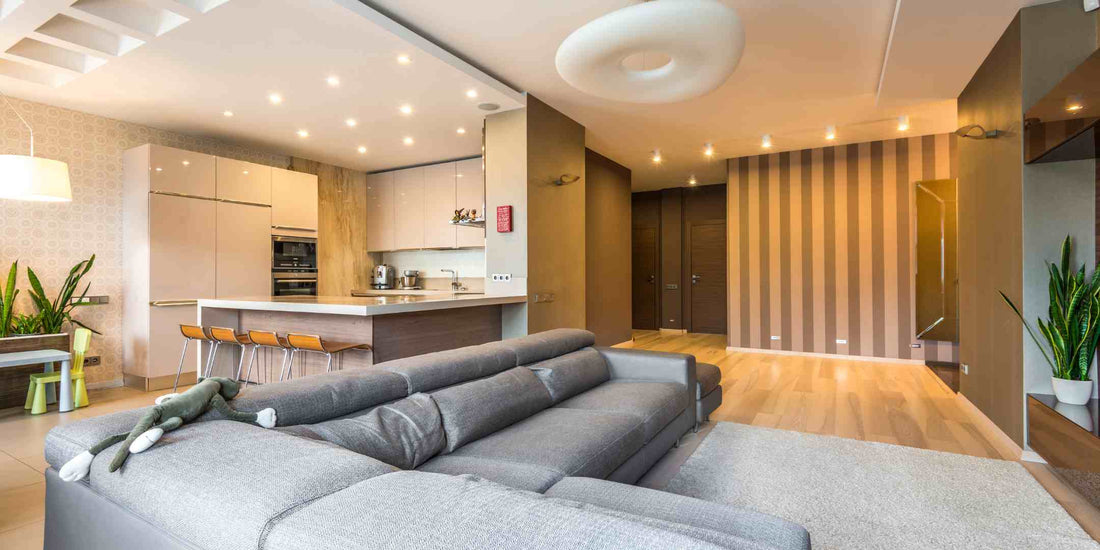
How To Combine Task, Ambient, and Accent Lighting
Share
Layered lighting means using three kinds of light:
- ambient (overall),
- task (work), and
- accent (drama).
Here's a complete, field-tested guide to layered lighting interior design that's not just theoretical, but practical and easy to implement. It's backed by expert details, practical room-by-room tips, and a few quirky opinions from the trenches.
What is the layered lighting approach?

Layered lighting is like a symphony of light in your space. It's an intentional design method that orchestrates different light 'layers' to create a harmonious and functional environment from morning to midnight.
The point isn't "more fixtures," it's control, so one room can multitask without glare or gloom. Interior Designers use this because it solves for function, comfort, and aesthetics all at once.
What are the three basic types of layered lighting in a room?
- Ambient (general) lighting – The overall, room-filling light: recessed downlights, a ceiling fixture, cove lighting, large pendants, or a wash from wall sconces. It sets the baseline for safety and orientation.
- Task lighting – Focused, brighter light where you read, chop, sew, or apply makeup: under-cabinet strips, desk lamps, pendant pools over an island, mirror-side sconces at eye level.
- Accent lighting – Aim this at art, stone, plants, bookshelves, or textured walls; it adds depth and visual hierarchy: picture lights, adjustable track heads, wall washers, in-cabinet LEDs.
Accent lighting isn't only for art collectors. Uplighting a plant or grazing a brick wall makes even small condos feel intentional and a bit luxe.
The nuts and bolts that actually matter (and are often ignored)
Lumens vs. watts:
Brightness is measured in lumens; watts measure energy use. Stop shopping by wattage—two 9W LEDs can be wildly different in brightness and beam spread. Look at lumens on the Lighting Facts label.
Color temperature (Kelvin):
Warm (≈2700–3000K) feels cozy; neutral (≈3500–4000K) reads clean; cool/daylight (≥5000K) looks crisp and can feel clinical at night. Mix deliberately (e.g., warm for living, neutral for kitchens/home offices).
CRI (Color Rendering Index):
CRI (0–100) describes how accurately colors appear under a light. Aim high (90+ where color is critical—vanity, wardrobe, finishes).
Controls:
Dimmers, multi-circuit switching, and bright scenes (morning/entertain/wind-down) are the "secret sauce" that make layering useful—not just pretty.
Beam spread & glare:
For pendants and spots, specify beam angles and diffusers; pair wide floods for ambient, narrower beams for art or task.
Tunable white & smart LEDs:
Color-tunable fixtures let you shift from energizing cool to evening-warm at the wall switch or app. Great for open-plan spaces that do everything.
How to properly layer lighting? (A step-by-step plan that works)
Step 1 — Map tasks & sightlines.
Mark where people cook, read, Zoom, do homework, or put on makeup. Those zones require task lighting with good color rendering and minimal shadows.
Step 2 — Establish the ambient first.
Use a combination of ceiling fixtures (recessed on wide beams, a central pendant/chandelier, or soft cove) and wall lights to avoid "downlight-only cave." Keep it dimmable.
Step 3 — Add a task where needed.
- Kitchens: Under-cabinet LED strips or pucks to flood the counter uniformly; pendants with the right beam spread over islands.
- Desks/reading: Adjustable arm lamp or desk task light with glare control.
- Vanities: Sconces at ~eye height on both sides of the mirror for even, shadow-free faces.
Step 4 — Finish with an accent.
Aim a 15–30° beam at art; graze stone or fluted panels; uplight a fiddle-leaf fig; toe-kick LEDs for nighttime navigation.
Step 5 — Put everything on controls.
At minimum: one dimmer for ambient, one for task, one for accent. Better: a simple smart keypad with scenes (e.g., "Cook," "Dinner," "Movie," "Midnight").
What are the benefits of layered lighting?
- Function you can feel: Cooking, reading, crafting, and studying are easier (and safer) with targeted light.
- Comfort & mood: Even, dimmable ambient light reduces eye strain; warm scenes help people wind down; cool-neutral light supports alert tasks.
- Design impact: Accent light creates depth, highlights texture, and makes modest spaces feel "finished" (hello, real-estate photos).
- Energy & code sanity: LEDs deliver the same lumens with a fraction of the watts; dimming and zoning keep usage efficient.
- Future-proofing: With smart or tunable-white LEDs, one room can shift from study hall to candlelit dinner vibe without swapping bulbs.
Layered lighting design pitfalls (and how to dodge them)
- All downlights, no walls: If the only light comes straight down, cheeks and countertops glow while walls fall dark. Add a wall light to expand the room visually.
- Harsh spot over a table: A tight-beam pendant creates hotspots and harsh shadows. Pick a larger shade or softer diffuser.
- Under-cabinet "dotting": Naked LED diodes cause scallops on backsplashes. Choose strips with a diffuser channel.
- Mismatched color temps: Keep a room's everyday scene within one step—e.g., 2700K ambient + 3000K task is fine; don't mix 2700K with 5000K in the same scene unless it's deliberate.
- No dimmers: Without dimming, a "perfect" plan still feels stuck at one mood all day.
Expert-backed shopper's checklist (save this for the store)
- Look for lumens, not watts. Check the Lighting Facts label. Typical living room scenes feel good around 1,500–3,000 total lumens from a mix of sources; bigger rooms need more.
- Pick color temp per room use. Warm (2700–3000K) for living/sleep; neutral (3500–4000K) for kitchens/work; high CRI (90+) for vanities, wardrobes, and finish-critical areas.
- Choose beam angles. 60–90° for general floods; 15–30° for art or focal points.
- Plan controls early. At least three zones: ambient, task, accent—each dimmable.
- Future-friendly? Consider tunable-white or smart bulbs that serve dual purposes.
How to properly layer lighting? (Quick scene recipes)
- Open-plan living/dining/kitchen:
- "Entertain" scene = 30% ambient + 70% pendants + 30% wall wash, task at 40% so food still looks fantastic.
- "Movie" = ambient 5–10% + toe-kick/night path 10% + a single lamp at 20% near the sofa.
- Small condo bedroom:
- Ambient 20% + headboard reading lights 60% + warm cove or strip at 15%. Instant hotel feel.
- Rental-friendly reset:
- No rewiring? Add two lamps (one floor, one table), replace a harsh bulb with a warm, dimmable LED, and stick an LED strip under a shelf. Three layers, one afternoon.
What are the benefits of layered lighting? (In real life)
- Meals look better, wood tones look richer, and skin reads more flattering under warm, high-CRI light.
- Kids study better with a neutral task light on the desk while the room stays softly lit (less glare = longer focus).
- Contractors get fewer callbacks for "space feels dark" when task lighting is specified from the start.
FAQ
What is the layered lighting approach?
A plan that blends ambient, task, and accent lighting—each on its own control—to hit visibility, comfort, and style in one scheme.
What are the three basic types of layered lighting in a room?
Ambient (overall), task (focused), accent (highlight)—and yes, you want all three.
How to properly layer lighting?
Start with dimmable ambient, add task exactly where it's needed, finish with targeted accent, and group them into scenes. Use lumens to size output, not watts.
What are the benefits of layered lighting?
Better function, less eye strain, more flattering spaces, and energy-savvy control—especially with efficient LEDs.
Layered lighting interior design ideas
Try wall washing on textured paint, under-cabinet task strips, a reading sconce with a cutoff shade, and a plant uplight. That quartet alone makes most living spaces feel "magazine-ready."
Final room-by-room cheat codes (copy/paste to your plan)
- Living: 2700–3000K ambient on dimmers + one reading task + one accent wash.
- Kitchen: 30 fc ambient; 50–75 fc counters with under-cabinet strips; pendants sized to overlap pools; high CRI near food.
- Dining: Wide, diffused pendant + perimeter sconces/wash; keep everything dimmable.
- Office: Neutral 3500–4000K desk task + soft ambient to cut contrast.
- Bath Vanity: Side sconces at eye height, balanced vertical illumination ≈20 fc; avoid single downlight over the mirror.
One last expert nudge

If a room feels "off," it's usually not the furniture—it's the light. Start with three layers, check lumens (not watts), pick the right Kelvin, and add dimmers. That's layered lighting design in practice—and it works in apartments, condos, and big family homes alike. When in doubt, stand where you'll actually do the task (chop, read, shave), and light that surface first. Then let ambient and accent do the rest.
